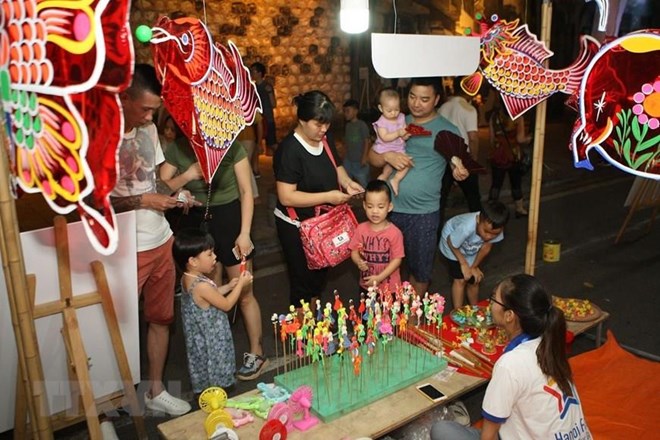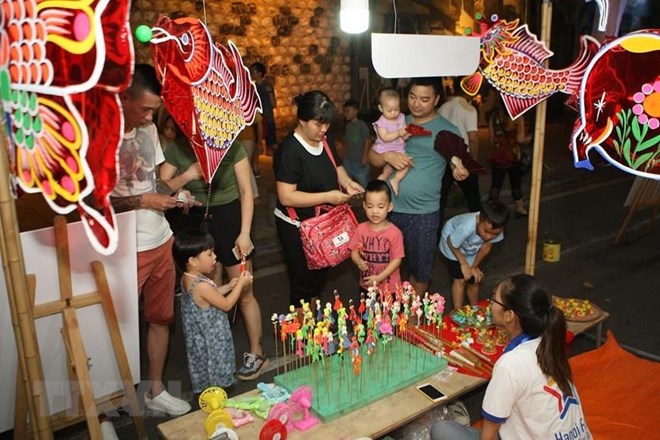
A myriad of activities are taking place in Hanoi on the occasion of the traditional Mid-Autumn Festival.
llustrative image
At an event from September 6-8 at the Thang Long Royal Citadel Complex, hundreds of valuable photos and various installations were on display and the sounds of drums of various sizes were heard throughout the capital.
Children came in crowds to watch lion dancing and enjoy folk singing. Not only kids but adults also joined in making carton masks and various folk games like tug of war and sack racing.
Meanwhile, the traditional old quarter mid-autumn festival has started at the main gate of Dong Xuan market and the walking street area of Hang Dao to Hang Giay streets.
The festival is being organised by Hoan Kiem district People's Committee.
Events are also happening in surrounding areas like the pedestrian zone in the Old Quarter, Hoan Kiem Lake pedestrian streets, the fresco art space of Phung Hung Street, Kim Ngan Communal House, the old quarter information and cultural exchange centre and the House of Legacy at 87 Ma May Street.
Traditional mid-autumn activities including lion dancing with competitors from 18 different wards, a night banquet, lantern parade, folk games and children's martial arts competition will take place.
 llustrative image.
llustrative image.
At the opening event, folk artisans will instruct visitors on how to make traditional folk toys such as paper lanterns, paper kites and ships. A puppet performance and the traditional mid-autumn organisation of a Hanoian family were also introduced.
"The organising board hopes to maintain traditional values, encourage people to protect their cultural legacy and honour the artisans," said deputy chairman of Hoan Kiem District People's Committee Dinh Hong Phong.
The festival lasts until September 13, or the full-moon day of the eighth month of the lunar calendar.
Source: VNA
With an increasingly vibrant and widespread emulation movement aimed at building cultured residential areas and cultured families, Yen Thuy District has been making steady progress toward improving both the material and spiritual well-being of its people, while fostering a civilized, prosperous, beautiful, and progressive community.
Once lacking recreational spaces and community facilities, Residential Group 2 in Quynh Lam Ward (Hoa Binh City) has recently received attention for the construction of a new, spacious, and fully equipped cultural house. The project followed the model of state support combined with public contributions in both labor and funding.
The "All people unite to build cultural life" movement, which has been effectively integrated with Kim Boi district’s socio-economic development goals, is fostering a lively spirit of emulation across local residential areas, hamlets, villages, public agencies, and enterprises. In addition, through the initiative, traditional cultural values are being preserved and promoted, while community solidarity and mutual support in poverty reduction and economic development are being strengthened.
A working delegation of the Hoa Binh provincial People’s Committee led by its Permanent Vice Chairman Nguyen Van Toan on June 11 inspected the progress of a project to build the Mo Muong Cultural Heritage Conservation Space linked to tourism services in Hop Phong commune, Cao Phong district.
Born and growing in the heroic land of Muong Dong, Dinh Thi Kieu Dung, a resident in Bo town of Kim Boi district, in her childhood was nurtured by the sweet lullabies of her grandmother and mother. These melodies deeply imprinted on her soul, becoming an inseparable part of her love for her ethnic group's culture. For over 20 years, this love for her hometown has driven Dung to research, collect, and pass down the cultural values of the Muong people to future generations.
In the final days of May, the Ethnic Art Troupe of Hoa Binh Province organized performances to serve the people in remote, mountainous, and particularly disadvantaged areas within the province. These were not just ordinary artistic shows, but they were the meaningful journeys aimed at spreading cultural values, enhancing the spiritual life of the people and contributing to the preservation of ethnic minority cultural identities.



 llustrative image.
llustrative image.